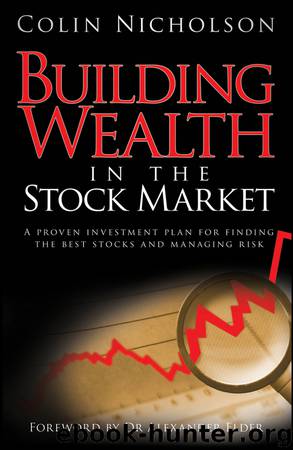Building Wealth in the Stock Market by Colin Nicholson

Author:Colin Nicholson
Language: eng
Format: epub
Publisher: Wiley
Published: 2011-11-08T16:00:00+00:00
Introduction to value and growth models
There are two mainstream investment approaches, or styles in the jargon of the industry. The two broad investment philosophies, within which we can classify almost all successful investors, are generally called the value method and the growth method. There are endless arguments in the investment community over which is the best method. However, I try to avoid what is surely a futile argument and one that will never be resolved absolutely. The truth is probably that both are successful over time for those who are expert in their use. One method might give better results for a time, but the balance inevitably swings to the other method for another period.
The value method
The value method derives from the ideas of Benjamin Graham. His most accessible book is The Intelligent Investor. The reasoning on which this method rests is that, since we cannot hope to predict the future consistently, our best course is to seek out companies that have shown consistently sound results over a significant period and which can be purchased cheaply in the market.
This idea that they should only be purchased when they are relatively cheap rests on Graham’s key investment idea, the margin of safety. What this means essentially is that, even if we are wrong about the company by a large factor, or it runs into trouble for a while, the odds are strongly in our favour.
The growth method
The growth method is probably best exemplified in the ideas of Philip Fisher in his book Common Stocks and Uncommon Profits. The reasoning on which it rests is that there are some truly outstanding companies. These outstanding companies will do far better than the market will do on average. In order to achieve outstanding results, we should seek out these companies and concentrate our investments on them.
Fisher’s method was based on extensive research to find and monitor these outstanding companies. He identified industries where he would be likely to find these companies, often related broadly to what we now call technology. He then searched out the very best companies in those industries.
It should be stressed that Graham and his followers are not against buying outstanding companies. However, where the value crowd differ is that they will only buy such companies on the rare occasions when they may be purchased relatively cheaply in the market.
The common elements in both methods
The interesting thing is just how much there is in common between the two methods. Indeed, they are best seen as the two extremes of a continuum. There is considerable middle ground, where both approaches might lead their adherents to buy the same companies at around the same time. After all, both might readily agree that the ideal is to buy outstanding companies cheaply.
Where they diverge is that the value adherents will not pay too much even for an outstanding company. They always aim to buy low and sell high. The growth adherents, on the other hand, are ready to buy outstanding companies at anything short of ridiculous prices.
Download
This site does not store any files on its server. We only index and link to content provided by other sites. Please contact the content providers to delete copyright contents if any and email us, we'll remove relevant links or contents immediately.
Rich Dad Poor Dad by Robert T. Kiyosaki(6174)
Pioneering Portfolio Management by David F. Swensen(6078)
How To Win Friends and Influence People by Dale Carnegie(4332)
The Money Culture by Michael Lewis(3846)
The Dhandho Investor by Mohnish Pabrai(3560)
The Wisdom of Finance by Mihir Desai(3523)
Liar's Poker by Michael Lewis(3221)
The Intelligent Investor by Benjamin Graham Jason Zweig(2930)
The ONE Thing by Gary Keller(2918)
Mastering Bitcoin: Programming the Open Blockchain by Andreas M. Antonopoulos(2891)
Fooled by Randomness: The Hidden Role of Chance in Life and in the Markets by Nassim Nicholas Taleb(2860)
Rich Dad Poor Dad: What The Rich Teach Their Kids About Money - That The Poor And Middle Class Do Not! by Robert T. Kiyosaki(2834)
Investing For Dummies by Eric Tyson(2794)
How to Win Friends and Influence People by Dale Carnegie(2793)
How to Day Trade for a Living: Tools, Tactics, Money Management, Discipline and Trading Psychology by Andrew Aziz(2785)
Market Wizards by Jack D. Schwager(2538)
Zero Hour by Harry S. Dent Jr. & Andrew Pancholi(2533)
How to Pay Zero Taxes, 2018 by Jeff A. Schnepper(2499)
Rich Dad's Guide to Investing by Robert T. Kiyosaki(2410)
